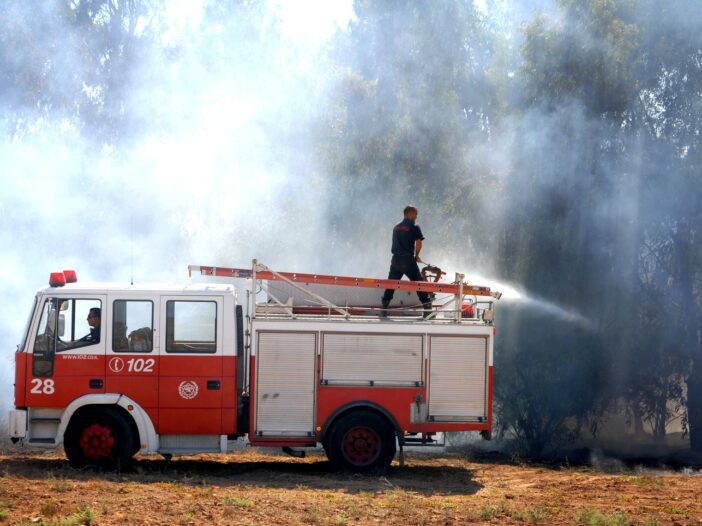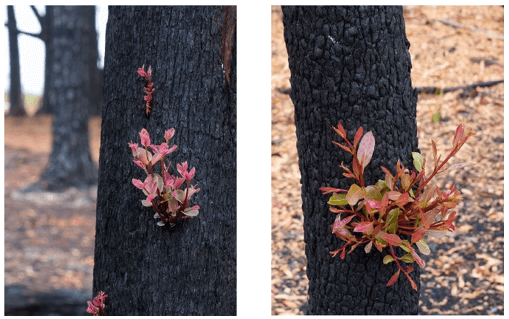It is a trying time for our country right now.
On everyone’s mind is the ongoing bushfire threat. A crisis that has been afflicting towns and communities right across the nation.
26 people have already lost their lives. Though fears the tally could rise are ever-present. Especially as summer still has a long ways to go yet.
No doubt there will be more devastation to come. More homes or livelihoods claimed by this catastrophe.
Our thoughts, from everyone at Money Morning, goes out to any and all affected.
Despite the ongoing threat though, it has been refreshing to see many Australians haven’t lost their sanguine perspective. Take these images shared by Murray Lowe from Kulnara in New South Wales for instance:
|
|
| Source: News.com.au |
You can read more about these images and Murray here, if you wish.
It is a striking reminder of the resilience of our natural flora. A land that has endured disaster before and likely will in future. Just as we, the inhabitants, do so as well.
We’ve been through tough times before, and while they’re never easy, in the aftermath we always see renewal.
And just like the plants that come back stronger and revitalised, so do we. It’s what we do best. As both individuals, and as a society.
Which is why these images are the perfect reminder for not just the fires, but also the state of business in Australia…
Fear up, consumption down
See our local businesses, but especially retail, are also enduring hardship. The latest trade data posted on Thursday highlighted the ongoing conundrum.
Record high exports to both the US and China has seen the surplus grow massively. From October to November, the final tally jumped 42% from $4.075 billion to $5.8 billion.
Once again, resources are the catalyst for this trade surge. Iron ore, coal, gas, and other minerals paved the way for huge demand abroad. That’s in spite of relatively weaker prices too.
However, more troubling is what is happening on the other side of the books.
It’s down 90% in 10 years…but is uranium about to surge 2,000% (again)? Find out in this FREE report
While exports are booming, imports are slipping. Overall demand for goods and services from overseas fell by 3%. A stat works out to roughly $1 billion worth of trade.
Similarly, consumption is also in freefall: down 7% during November. Equating to $610 million worth of lost sales for the business sector. Which may set the tone for a weaker quarter all round.
Long story short, retailers are in a world of pain.
You don’t need any data to know that though. Just this week we’ve seen three companies publicly showcasing the tough times.
Fashion chain Bardot is set to close 58 stores and cut 530 staff. Leaving them with just 14 outlets left and some 270 staff.
Similarly, EB games is also set to close 19 stores over January. The first of what may be many closures in the months ahead.
And then there was the big one.
The total collapse of McWilliam’s Wines.
After 141 years of operation, this family-owned business is no more. Having been handed over to administrators this week, what little value is left will be stripped and likely sold off.
Suffice to say, retailers are struggling right now.
But, just like the regrowth of our land, there is regrowth for business. The sprouts of regeneration are visible — if you know where to look.
Signs of growth
E-commerce is the best avenue for growth in retail.
I realise that isn’t a revolutionary claim, but I feel the need the stress it once again. Online sales, despite their ubiquity nowadays, are still being overlooked by retailers.
Any business hoping to thrive is ignoring the internet at their own peril.
For the 12 months to November, online spending topped $30.14 billion in Australia. A 9.4% increase year-on-year.
Quite the contrast to the dismal affairs of brick and mortar outlets. And yes, that is because online sales are only a small portion of total sales. But, it is growing bigger every year.
As of November, 9.2% of all retail sales are now made online. A figure that is only growing by the day.
Furthermore, I expect it will keep growing. Perhaps at even faster rate than it is currently.
I firmly believe we haven’t reached peak e-commerce yet. It is an industry that still has room for innovation and improved efficiency.
Things like: better utilisation of data, mobile and app integration, as well as virtual/augmented reality are just some of the ways online sales could be transformed.
Not to mention the changes we may see to logistics. Such as drone delivery, driverless transportation or flying warehouses (yes, it’s a possibility).
Because of this I wouldn’t touch a retail company that doesn’t have a confident online strategy. That doesn’t mean they have to be online-only, but they would need some sort of digital presence. After all, the retailers who understand online sales are the ones currently thriving.
Just look at some of the better performing, publicly listed retailers. JB Hi-Fi Ltd [ASX:JBH], Kogan.com Ltd [ASX:KGN], and Temple & Webster Group Ltd [ASX:TPW] are all powering ahead. Three ‘e-tailers’ who know how to make the most of online sales.
So, despite the upheaval of the retail sector right now, I’m not all that worried. At least not long term.
Yes some businesses will disappear, some of which may have long legacies. But, that’s just the nature of business. Times change, and the old must make way for the new.
The important thing is that we minimise the damage while nourishing the renewal. In the end, we will be stronger for it.
Because no matter what, you can’t stop the resilience of our land and our people.
Regards,
Ryan Clarkson-Ledward,
Editor, Money Weekend


